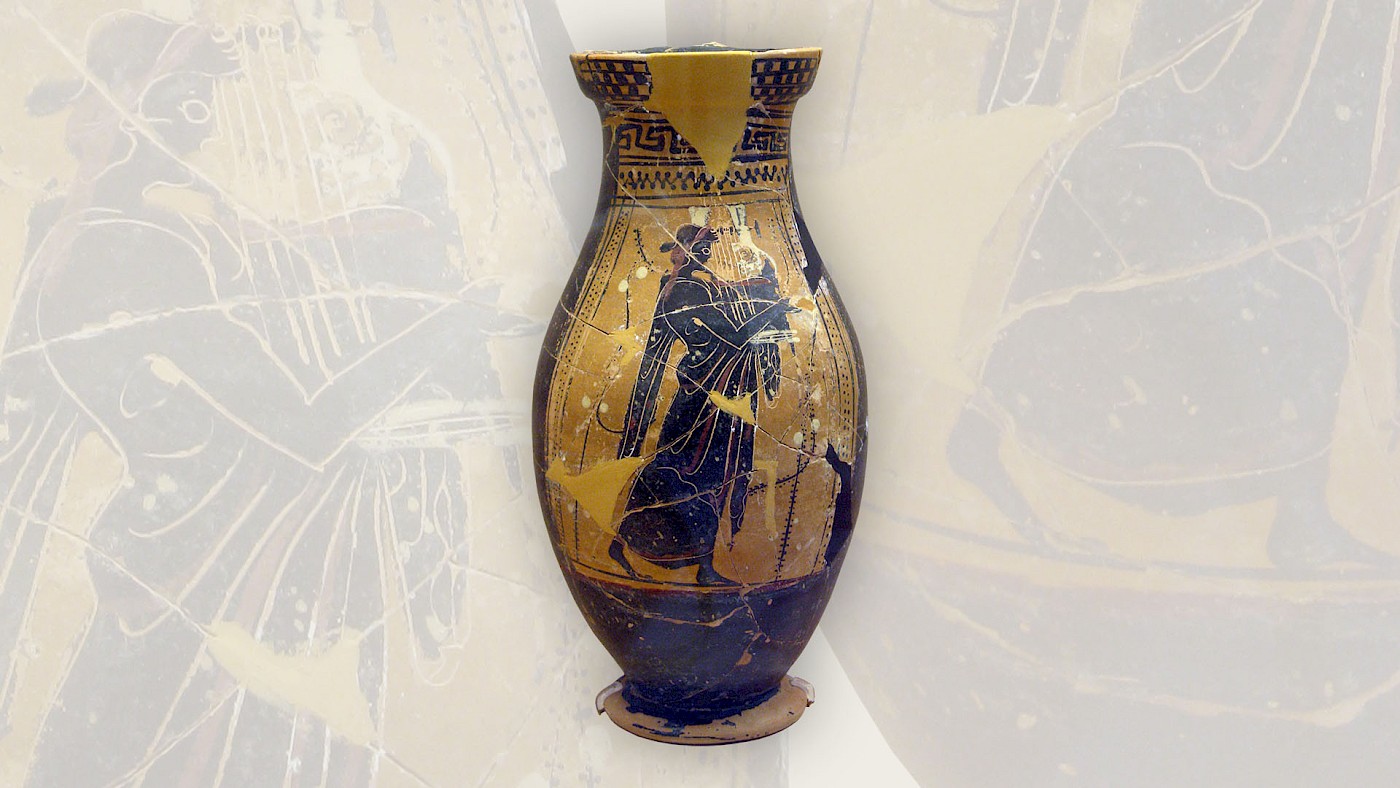The archaeological museum of Rhodes features a good collection of imported Attic black- and red-figure pottery. Among their number is the slender olpe or wine jug depicted in this article’s featured image. The ancient Greek word olpe has been applied to pots of this type, but there is no reason to assume that the ancient Greeks meant this specific type of vessel when they used that word; it’s a modern shorthand.
The jug was recovered from the tomb of an infant at the site of Laerminaci, no. T 224 (2). Other vessels recovered from this grave include an Attic eye-cup, as well as two lekythoi, which are slender bottles used for oil. The inclusion of pottery used for alcohol consumption – the olpe and the cup – during the symposium is interesting, as the owner of the grave – an infant – was clearly too young to have ever taken part in a drinking party.
The pottery refers to the infant’s social status, rather than what they may have done in life. This is something that is often easily forgotten. A good example is the presence of weapons in a grave. The fact that a person is buried with arms doesn’t necessarily mean that they were warriors in life; as with this infant, the weapons may instead be a reference to social status – metal objects are expensive – as much as anything else. Burials with arms are not necessarily “warrior graves”.
“Painter of Würzburg 351”
The painted decoration on this vessel has been attributed to the “Painter of Würzburg 351”. This is in reference to a painter who was first identified by art historian John Beazley (1885-1970) on an oinochoe (another type of wine-jug) in the Martin von Wagner Museum of the Universität Würzburg, with inventory number L351.
Beazley devoted his life to studying Attic pottery, seeking to identify different painters by analysing details, such as how eyes were painted or fingers were rendered. Beazley believed that such distinguishing marks could be used to identify individual artists.
Only a small number of potters and painters actually signed their work. Hence, the “Painter of Würzburg 351” is the designation used to refer to what Beazley believed was a single person who had painted a number of vessels either unearthed by archaeologists or bought on the antiquities market.
There is ample reason to not put much stock into the concept of “connoisseurship”. I have discussed the problems in earlier articles, namely here and here. The short version is that this kind of scholarship should be treated with a large grain of salt. Perhaps this vessel in Rhodes was decorated by the same person who painted the oinochoe in Würzburg – or perhaps not. It doesn’t really matter either way.
But let’s take a look at what is actually depicted on this vessel’s body. The scene includes a tall man with a lyre. He wears a long garment and has something tied around his head. The museum identifies the figure as the god Apollo. In art, most of the gods can be distinguished from one another only by their attributes. In this case, the lyre is thought to refer to Apollo as the god of music.
Another interpretation
However, I have my doubts that the figure is supposed to be Apollo. If you look around the figure, you will see that some kind of vegetation has been painted. These long lines with small leaves attached are well-known from other painted scenes and invariably represent vines. But Apollo is not the god of the vine – that would be Dionysos.
In art, Dionysos is generally represented as holding a kantharos or drinking cup in his hand, rather than a musical instrument. Perhaps, then, we are not dealing with a deity, but with some other character who is associated in some manner with Dionysos.
I would propose that the figure depicted here is actually Orpheus. His story is well known. He was a musician from Thrace who managed to move both humans and animals with his song. He was also one of the Argonauts: during the quest for the Golden Fleece, he charmed the alluring Sirens into silence.
Eurydice, Orpheus’ young wife, died after being bitten by a viper. Distraught, Orpheus descended into the Underworld to recover her. Hades, the ruler over the shades (souls) of the dead, allowed Orpheus to take Eurydice back to the surface on the condition that she would follow him and he wouldn’t look at her until they had returned to the world of the living.
Of course, Orpheus couldn’t resist. Even though they were close to the exit of the underworld, he couldn’t hear his beloved’s footsteps anymore and so glanced back. Immediately, Eurydice was yanked back into Hades’ realm and Orpheus was not allowed back inside. In one version of the story, Orpheus wandered the world despondently until he eventually ran across the Maenads, the raging women who worship Dionysos. He refused to move aside for them and so they tore him to pieces.
Orpheus died well before his time. Perhaps this was a reason for why the parents of this tomb’s unfortunate infant included this pot among the goods that they entrusted to the earth.
